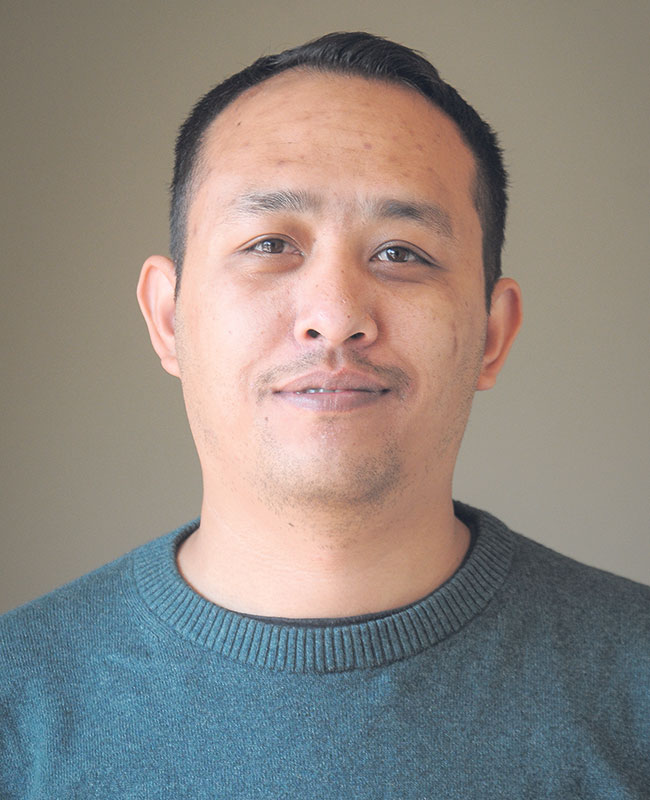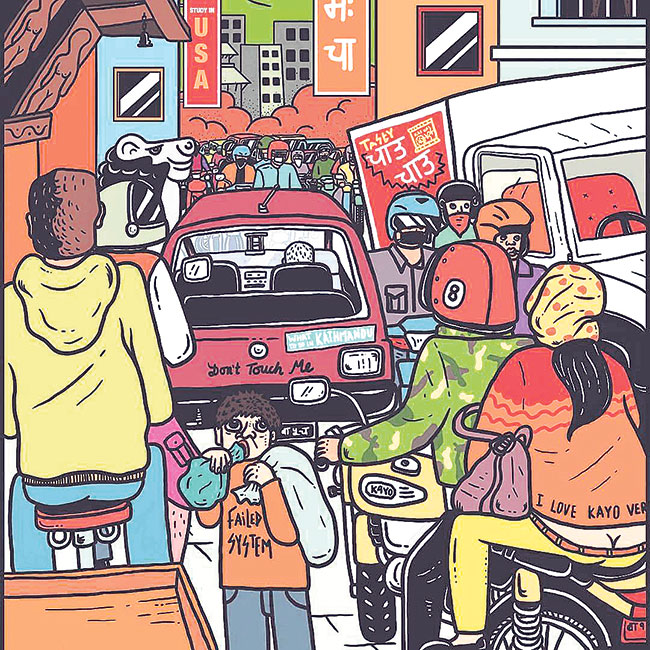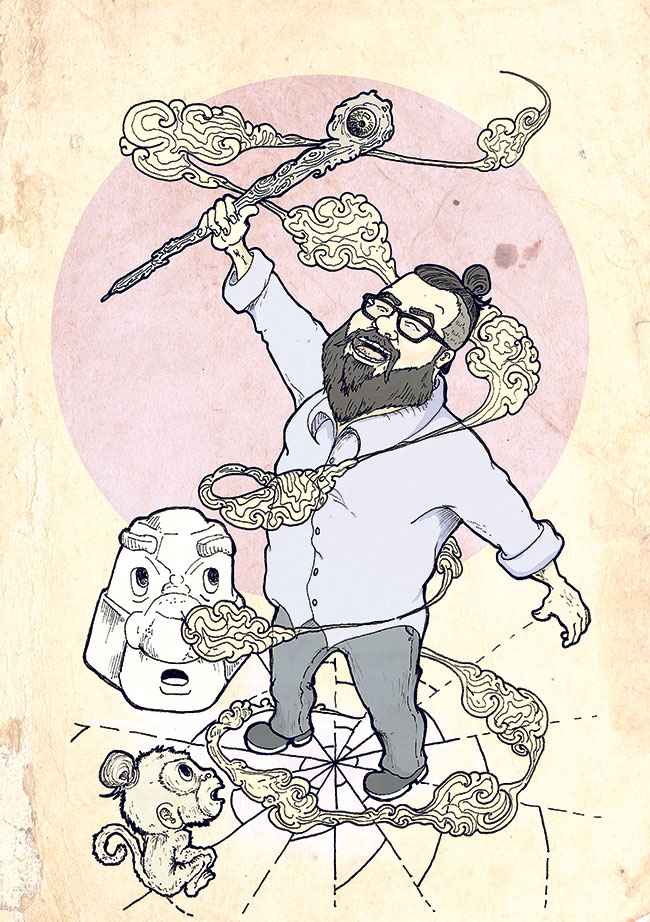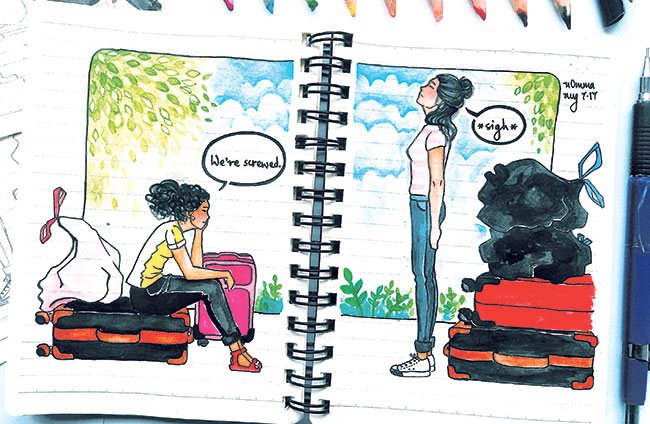For an artist, nothing can tell a story better than an outstanding illustration. That is why most of them are driven with the passion to convey their thoughts through visual narratives. With increasing number of outstanding artists in Nepal, illustrations can be spotted everywhere. From concerts, restaurant walls, graphic t-shirt to our Instagram feeds, these quirky artworks never fail to catch our attention.
While some of these artists use their creations as a symbol of revolution and hope, others just pursue it as a hobby. But only a few of them have inspired youths of their generation and many more to come. We caught up with these creative and inspirational masterminds to understand their stories and the idea behind their wonderful work that has given an inventive twist to Nepali creativity.
The Revolutionary
 Prachin Siddhi Bajracharya, popularly known as Kayo Siddhi, makes designs based on the contemporary social and political context of Nepal. “I like making illustrations that are relevant to the present social setting. Some of my illustrations may bring a smile across the viewers face and some might make them angry,” says Bajracharya. But, according to him, each of his work is intended to create a great impact on people’s lives.
Prachin Siddhi Bajracharya, popularly known as Kayo Siddhi, makes designs based on the contemporary social and political context of Nepal. “I like making illustrations that are relevant to the present social setting. Some of my illustrations may bring a smile across the viewers face and some might make them angry,” says Bajracharya. But, according to him, each of his work is intended to create a great impact on people’s lives.
 He makes art that stimulates the minds of its audience and compels them to think. One of his favorite illustrations is ‘Gari Khana Deu’ which was made for the band Albatross Nepal. The design was printed on their t-shirt. ‘Gari Khana Deu’ literally means let us earn our own living. Bajracharya says this t-shirt was released at the time when Nepal constantly faced political strikes which hampered the livelihood of many Nepalis.
He makes art that stimulates the minds of its audience and compels them to think. One of his favorite illustrations is ‘Gari Khana Deu’ which was made for the band Albatross Nepal. The design was printed on their t-shirt. ‘Gari Khana Deu’ literally means let us earn our own living. Bajracharya says this t-shirt was released at the time when Nepal constantly faced political strikes which hampered the livelihood of many Nepalis.
“Our education system, business houses, and governance everything was hindered due to those strikes. That is why I made a burning Safa Tempo as a symbolic resistance to the entire scenario,” says Bajracharya.
Bajracharya was initially a business student. “I studied business in my bachelors but I always knew I could never do boring 9 to 5 office jobs. So I decided to build my career on something I was good at,” he says.
Mothers in wake of foreign employment: Struggles with unwanted...

He is popularly known with the name ‘Kayo’ which was his grandmother’s name. “I found Kayo extremely attractive and quirky. So I decided to go with Kayo. It was only later that I found out that Kayo in Newari means a fair girl,” says Bajracharya.
Since 2005, Bajracharya has worked for various clothing lines, brands, non-governmental organizations and corporate houses. His design ‘The Dark Side of the Momo’ on Juju t-shirts has been liked by a wide range of audience. “The Dark Side of the Moon is a popular song by one of my favorite bands, Pink Floyd. ‘The Dark Side of the Momo’ design is inspired by that song. It is one of my commercially popular artwork and I love watching people wear it on the streets,” says Bajracharya.
The Storyteller

“I have a great thirst for visual narration. When I was a kid, I either wanted to be a superhero or an artist. That is why, I guess, I like making graphic novels now,” says Prakash Ranjit who, like many of us, grew up reading comic books.
Ranjit believes in the power of storytelling to inspire, communicate, educate, and share ideas among people, both young and old. His stories are mostly told though illustrations and he strongly feels that this medium can spark revolution, carry legacies, and record unwritten histories.
Ranjit started illustrating at the age of three. He believes that art has always been a part of his identity. Even Ranjit’s grandfather was an ‘artivist’, promoting activism through art. “A lot of my works are conceptually inspired by my grandfather,” says Ranjit.
 In the recent years, he has been working on sequential illustrations and graphic novels. He also released his first comic book titled Lumankati in 2017. “It is a comic book based on our traditional oral history and myths that dates back to the 17th century,” says Ranjit adding that he felt humbled to be a part of such an outstanding book.
In the recent years, he has been working on sequential illustrations and graphic novels. He also released his first comic book titled Lumankati in 2017. “It is a comic book based on our traditional oral history and myths that dates back to the 17th century,” says Ranjit adding that he felt humbled to be a part of such an outstanding book.
He takes inspiration from real people and their facial expressions while making any comic characters. All his illustrations are made after taking a close look at people’s faces and body language in particular situations.
Ranjit’s new personal project is a series of caricatures. “I have made caricatures of myself and of my friends whom I know and who have inspired me. I show them their strengths and their abilities through these caricatures. I believe these are my real life super heroes and they do magical things each day,” says Ranjit.
According to Ranjit, he does not really have a particular style. This young illustrator can do anything that his heart desires. “I believe in inventing, discovering, and exploring new ideas and styles,” says Ranjit. He has also made political satires that have gained popularity in the past. One of this favorite satirical art is a fat cartoon character sitting on a bathtub surrounded by cracked walls under a dry shower. “I feel this sketch depicts our reality. You see, we all live in a state of obliviousness. Our houses may be tearing apart and our country may be in a bad state but we still fail to care about anything else but ourselves,” he concludes.
The young dreamer

Just like everybody else in the art world, Norima Shakya’s art journey started with tiny doodles and scribbles in the corners of her school notebooks. “I don’t remember exactly when I started doodling but I have been doing it for as long as I can remember, and I haven’t stopped since,” says Shakya.
She also soon realized that it was more fulfilling to draw real people than just making random doodles on the edges of her books. So she started illustrating for her friends and for a few customers. “The joy of seeing their expressions after I handed them the finished artwork was priceless,” says Shakya.
 These days, along with drawing figures, she has also been trying to portray real life events in her illustrations. “I recently made a drawing of my roommate and I stranded in the streets along with all our belongings. This was based on my own personal experience as my friend and I had to vacate the apartment we were living in at a moment’s notice due to some misunderstanding,” says Shakya.
These days, along with drawing figures, she has also been trying to portray real life events in her illustrations. “I recently made a drawing of my roommate and I stranded in the streets along with all our belongings. This was based on my own personal experience as my friend and I had to vacate the apartment we were living in at a moment’s notice due to some misunderstanding,” says Shakya.
One of her most popular works on Instagram is of a Newari girl with a Dhaka pattern in the background. “This is one of my favorite works so far. The Dhaka pattern actually took me two hours to complete,” she says.
Art has always been a way for her to express her thoughts. Drawing and painting have become an essential part of her life and she needs to put down all her thoughts into her sketchbook each day.
“My need to express my thoughts artistically is probably hereditary because I come from an artistic background. My family makes exquisite Buddhist statues and I grew up watching my dad go to extreme lengths to make a perfect statue. I guess I get my artistic qualities from him and my love for details also comes from him. I aspire to create beautiful artworks like he does in the future,” says Shakya.
She is also aware of the fact that making a career is art is not easy. “I know it will be difficult for me to pay the bills and I may not be able to get everything I want but, at the end of the day, getting appreciated for my work will be worth it,” says Shakya who feels that she has come a long way from making doodles on every page to getting appreciated from strangers all around the world. In the future, she intends to turn it into more than just a hobby and see where it takes her.







































